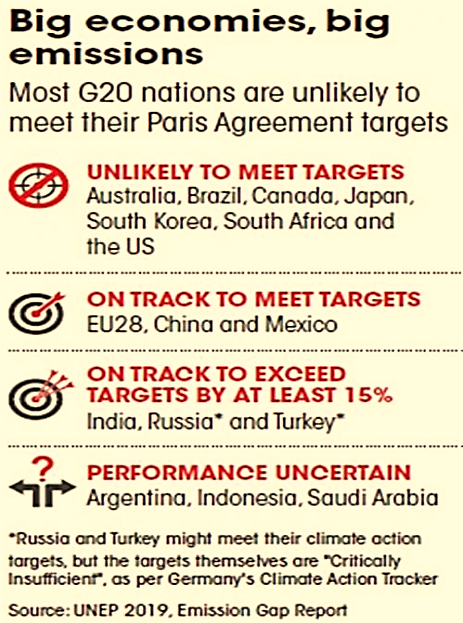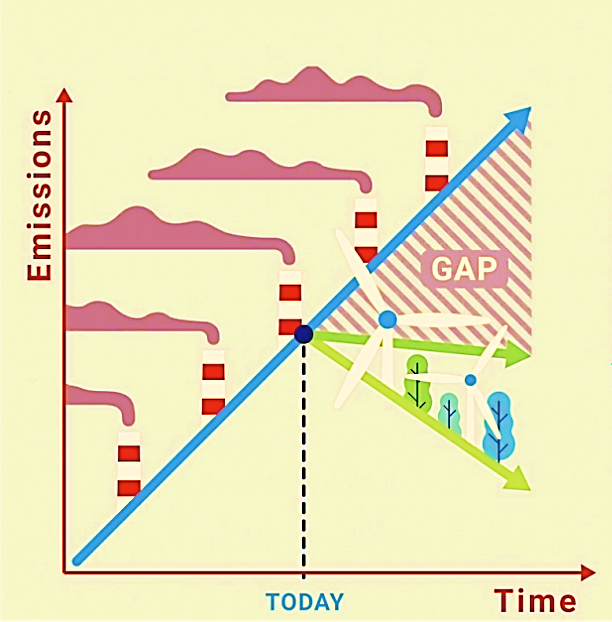UNEP Emissions Gap Report – 2019
- 02 Dec 2019
- Recently, the United Nations Environment Programme (UNEP) released a report under the title- United Nations Gap Emissions Report-2019, which presents a grim assessment on the yawning gap between 'what countries have committed and what they actually require to do to limit greenhouse gas(GHG) targets'.
About the Report
- The Report, tenth in series, provides an independent scientific assessment of how countries’ climate pledges and actions are affecting the global greenhouse gas emissions (GHG) trend, comparing it with the emission reductions necessary to limit global warming in accordance with the Paris Agreement.
- This year’s report emphasizes the energy and transport sector, arguing that renewables and energy efficiency, together with electrification of end uses are key to driving down energy-related CO2 emissions.
- It identifies six entry points for progressing towards closing the emissions gap through transformational change in the following areas:
- Air pollution, air quality, health
- Urbanization
- Governance, education, employment
- Digitalization
- Energy- and material-efficient services for raising living standards
- Land use, food security, bioenergy
Major Findings
GHG Emissions Continue To Rise
- GHG emissions have risen at a rate of 1.5 percent per year in the last decade, stabilizing only briefly between 2014 and 2016. Total GHG emissions, including from land-use change, reached a record high of 55.3 Gt carbon dioxide(CO2) emission in 2018.
- By 2030, emissions would need to be 25 percent and 55 percent lower than in 2018 to put the world on the least-cost pathway to limiting global warming to below 2˚C and 1.5°C respectively.
Top Emitters
- The top four emitters (China, EU28, India and the United States of America) contributeto over 55 percent of the total GHG emissions over thelast decade excluding LUC, the top seven (including Japan,Russia and international transport) account for 65 percent, while G20 members contribute 78 percent.
- Sectors that are the largest emitters- Energy>Industry>Forestry>Transport>Agriculture>Building.

Net Zero Emission
- Although the number of countries announcing net zero GHG emission targets for 2050 is increasing, only a few countries have so far formally submitted long-term strategies to the UNFCCC.
- Five G20 members (the EU and four individual members) have committed to long-term zero emission targets, of which three are currently inthe process of passing legislation and two haverecently passed legislation. The remaining 15G20 members have not yet committed to zeroemission targets.
Large Emission Gap
- The emissions gap is large. In 2030, annual emissions need to be 15 GtCO2e lower than current unconditional NDCs imply for the 2°C goal, and 32 GtCO2e lower for the 1.5°C goal.
Strengthening the Nationally Determined Contributions (NDCs)
- Dramatic strengthening of the NDCs is needed in 2020. Countries must increase their NDC ambitions threefold to achieve the well below 2°C goal and more than fivefold to achieve the 1.5°C goal.
India’s Recent Developments towards Emission Gap
Suggestive Measures for India
|
What is Emission Gap?
- The Emissions Gap (also Commitment Gap), measures the gap between what we need to do and what we are actually doing to tackle climate change.
- The gap is the difference between the low levels of emissions that the world needs to drop to, compared with the projected level of emissions based on countrie’s current commitments to decarbonization.
Why is it important?
- The gap is important because if we can’t close it and meet the emissions reduction target, the world is going to face increasingly severe climate impacts worldwide.
- It is important that policymakers, and their citizens, know what the gap is so that the commitments countries are making are sufficient to close the gap.

Way Forward
- However, the report points thatclimate change can still be limited to 1.5°C. For this, the countries must increase their ambition immediately to close the emissions gap by strengthening emissions-reduction targets, as well as sectoral targets such as those related to renewable energy.Countries can commit to implementing their NDCs in line with achieving net-zero emissions by 2050.
- Countries must realize the role of ‘non-state actors’ (such as companies and NGOs) and sub-nationals (state governments and city administrations) in achieving the global warming targets. It also calls for taxing of carbon to dissuade CO2 emitting activities.
- If the multiple co-benefits associated with closingthe emissions gap are fully realized, the requiredtransition will contribute in an essential way toachieving the United Nations 2030 Agenda with its17 Sustainable Development Goals (SDGs).




